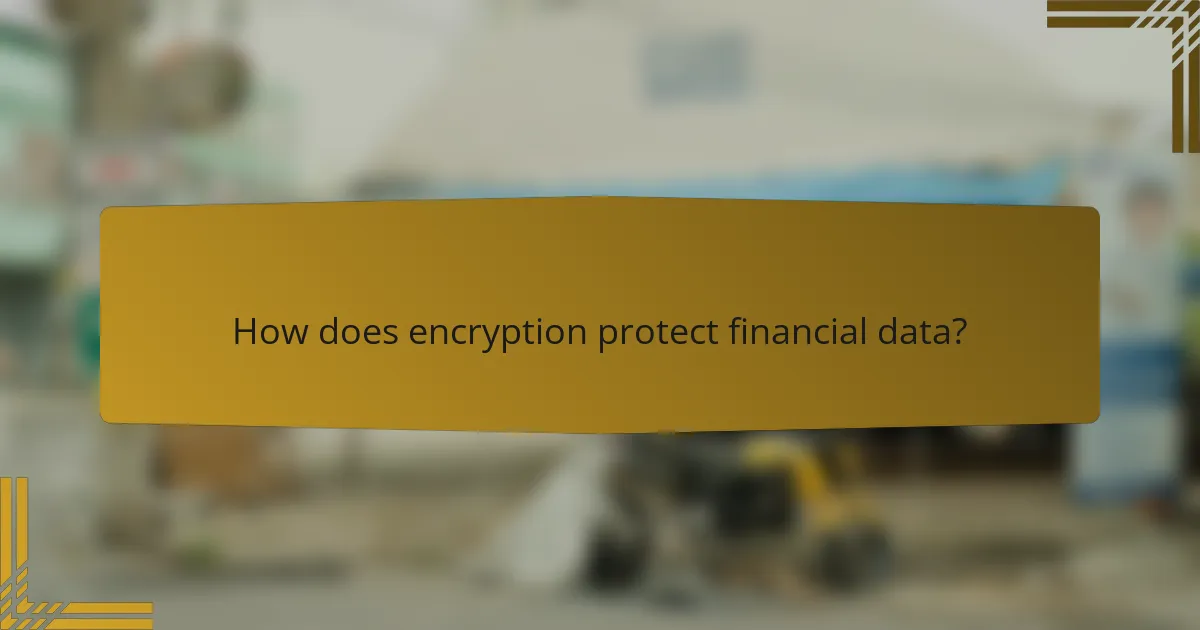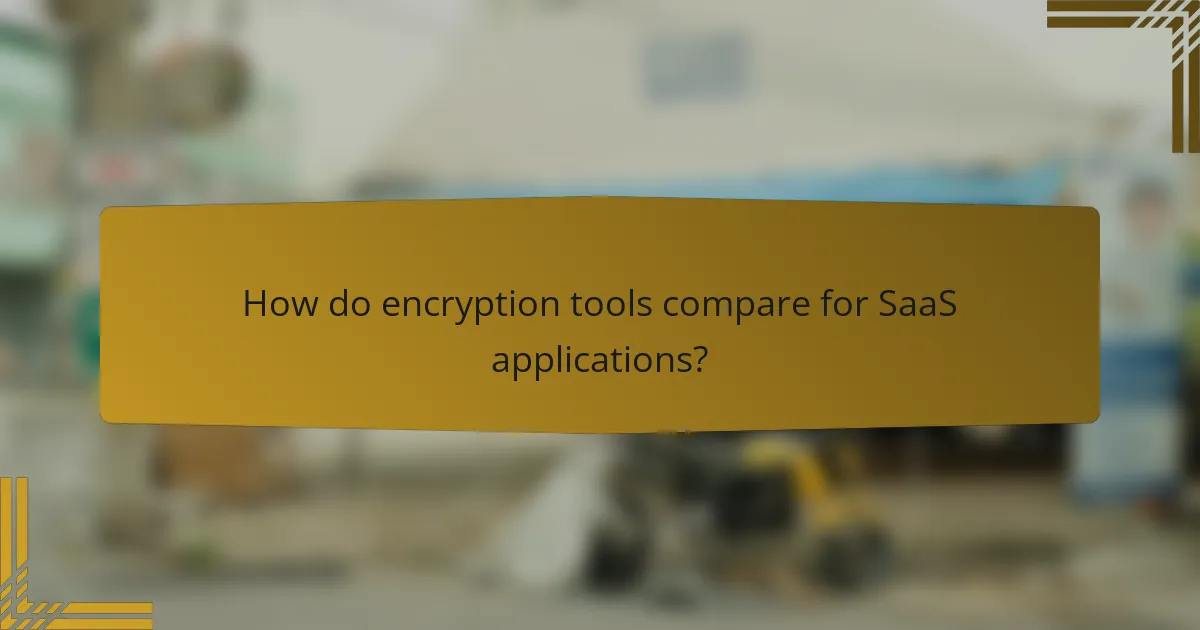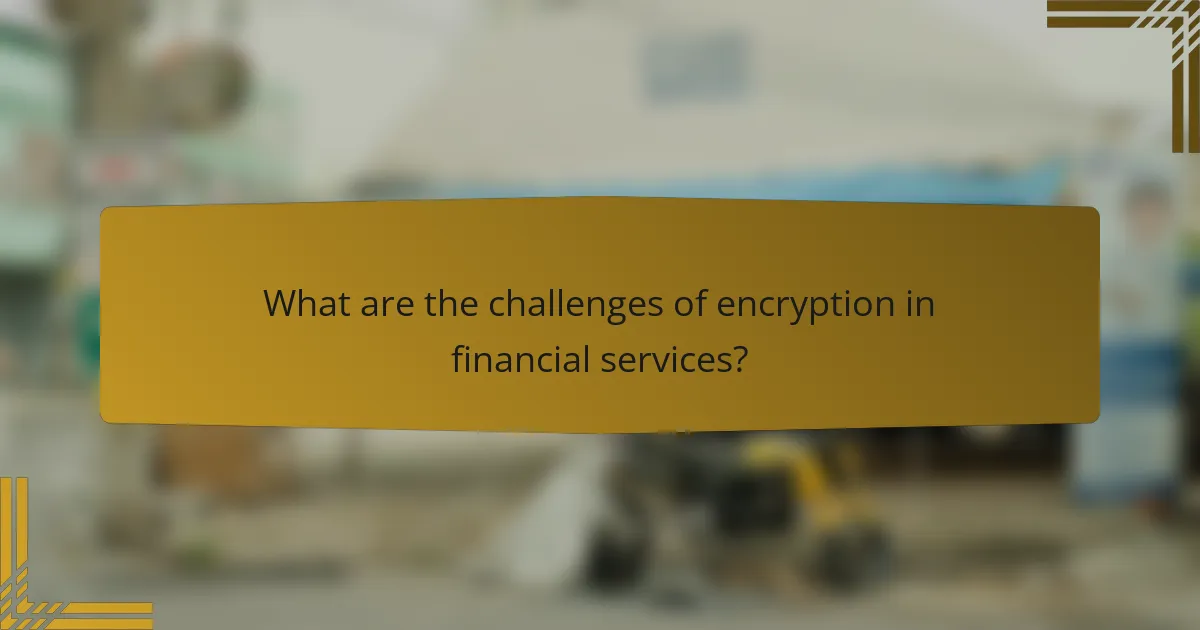Encryption plays a vital role in ensuring financial security by safeguarding sensitive data from unauthorized access. By converting information into a coded format, it protects personal and financial details during transactions and storage, thereby maintaining compliance with regulations and customer trust. Effective implementation of encryption involves adhering to best practices, including regular updates and the use of strong algorithms to enhance data integrity and security.

What are the encryption solutions for financial security in Canada?
Encryption solutions for financial security in Canada include various methods that protect sensitive data from unauthorized access. These solutions are crucial for safeguarding personal and financial information, ensuring compliance with regulations, and maintaining customer trust.
End-to-end encryption
End-to-end encryption (E2EE) ensures that data is encrypted on the sender’s device and only decrypted on the recipient’s device, preventing intermediaries from accessing the information. This method is particularly important for financial transactions, as it protects sensitive details such as account numbers and personal identification from potential breaches.
When implementing E2EE, consider using established protocols and libraries to avoid vulnerabilities. Regularly update your encryption methods to keep pace with evolving security threats.
Data-at-rest encryption
Data-at-rest encryption protects stored data on devices or servers, making it unreadable without the appropriate decryption key. This is essential for financial institutions that handle large volumes of sensitive customer data, as it mitigates risks associated with data breaches and unauthorized access.
To implement data-at-rest encryption, use strong encryption algorithms such as AES-256. Regularly audit your encryption practices to ensure compliance with Canadian regulations and industry standards.
Transport Layer Security (TLS)
Transport Layer Security (TLS) is a protocol that secures data transmitted over networks, ensuring that information exchanged between clients and servers remains confidential and integral. TLS is vital for online banking and e-commerce platforms, as it protects sensitive transactions from interception.
For effective TLS implementation, always use the latest version and configure your servers to disable outdated protocols. Regularly monitor your TLS certificates and renew them before expiration to maintain secure connections.
Multi-factor authentication integration
Multi-factor authentication (MFA) adds an extra layer of security by requiring users to provide two or more verification factors to access their accounts. This is particularly important in the financial sector, where unauthorized access can lead to significant financial loss and identity theft.
To effectively integrate MFA, consider using methods such as SMS codes, authentication apps, or biometric verification. Ensure that users are educated on the importance of MFA and encourage its adoption to enhance overall security.

How does encryption protect financial data?
Encryption protects financial data by converting it into a coded format that can only be read by authorized parties. This process ensures that sensitive information remains confidential and secure from unauthorized access, especially during transactions and data storage.
Prevents unauthorized access
Encryption acts as a barrier against unauthorized access by scrambling data so that only individuals with the correct decryption key can read it. For instance, when financial institutions encrypt customer information, even if hackers gain access to the data, they cannot interpret it without the key.
Implementing strong encryption protocols, such as AES (Advanced Encryption Standard), is crucial for safeguarding sensitive financial data. Regularly updating encryption methods and keys helps maintain security against evolving threats.
Secures sensitive transactions
During online transactions, encryption secures sensitive information like credit card numbers and personal identification details. This is typically achieved through protocols like SSL (Secure Sockets Layer) or TLS (Transport Layer Security), which encrypt data in transit between a user’s device and the financial institution’s server.
For example, when making a purchase online, look for URLs that begin with “https://” as this indicates that the site uses encryption to protect your transaction details. Always ensure that the payment page is secure before entering sensitive information.
Maintains data integrity
Encryption not only protects data from unauthorized access but also maintains its integrity by ensuring that it has not been altered during transmission. Techniques such as hashing can be used alongside encryption to verify that data remains unchanged.
For financial data, maintaining integrity is critical; even minor alterations can lead to significant errors in transactions. Regular audits and checks can help ensure that encrypted data remains intact and reliable.

What are the best practices for implementing encryption?
Implementing encryption effectively requires adherence to several best practices that enhance security and ensure data integrity. Key practices include regularly updating encryption protocols, conducting audits, and utilizing strong encryption algorithms to safeguard sensitive information.
Regularly update encryption protocols
Regular updates to encryption protocols are essential to protect against emerging threats and vulnerabilities. Outdated protocols may have known weaknesses that can be exploited by attackers, leading to data breaches.
To maintain security, organizations should monitor industry standards and update their encryption methods at least annually or whenever significant vulnerabilities are discovered. This includes transitioning from older protocols like SSL to more secure options such as TLS.
Conduct encryption audits
Conducting regular encryption audits helps identify weaknesses in existing encryption practices and ensures compliance with relevant regulations. Audits should assess the effectiveness of encryption methods, key management practices, and access controls.
Organizations can implement a schedule for audits, such as quarterly or bi-annually, and involve third-party security experts for an unbiased evaluation. This proactive approach helps mitigate risks and enhances overall security posture.
Utilize strong encryption algorithms
Utilizing strong encryption algorithms is critical for protecting sensitive data. Algorithms such as AES (Advanced Encryption Standard) with a key size of at least 256 bits are recommended for robust security.
When selecting encryption algorithms, consider factors such as performance, compatibility, and regulatory requirements. Avoid using deprecated algorithms like DES or RC4, as they are no longer considered secure.

What are the regulatory requirements for encryption in Canada?
In Canada, regulatory requirements for encryption focus on protecting sensitive data, particularly personal information and payment details. Organizations must comply with specific legislation and standards that dictate how encryption should be implemented to safeguard data integrity and confidentiality.
Personal Information Protection and Electronic Documents Act (PIPEDA)
PIPEDA mandates that organizations must protect personal information through appropriate security measures, including encryption. This law applies to private-sector organizations and requires them to implement safeguards that are proportional to the sensitivity of the information they handle.
To comply with PIPEDA, businesses should assess the types of personal data they collect and determine the level of encryption necessary. For instance, sensitive information like health records or financial data may require stronger encryption methods compared to less sensitive data.
Payment Card Industry Data Security Standard (PCI DSS)
PCI DSS outlines security requirements for organizations that handle credit card information, emphasizing the need for encryption to protect cardholder data. Compliance with PCI DSS is crucial for any business that processes, stores, or transmits credit card information.
Organizations must use strong encryption protocols, such as AES-256, for data at rest and in transit. Regular assessments and audits are necessary to ensure ongoing compliance, and businesses should avoid common pitfalls like using outdated encryption methods or failing to encrypt sensitive data entirely.

How do encryption tools compare for SaaS applications?
Encryption tools for SaaS applications vary in features, performance, and cost, making it crucial to evaluate them based on specific needs. Key factors include the level of security provided, ease of implementation, and ongoing maintenance requirements.
Comparison of encryption software features
When comparing encryption software for SaaS, consider features such as data-at-rest and data-in-transit encryption, key management capabilities, and compliance with industry standards like GDPR or HIPAA. Some tools offer end-to-end encryption, ensuring that only authorized users can access sensitive data, while others may provide less robust options.
Additionally, look for user-friendly interfaces and integration capabilities with existing systems. Features like automated key rotation and audit logs can enhance security and simplify compliance tracking.
Cost analysis of encryption solutions
The cost of encryption solutions for SaaS applications can vary widely, typically ranging from a few hundred to several thousand dollars per year, depending on the provider and features included. Subscription models are common, allowing businesses to pay monthly or annually based on usage and the number of users.
When evaluating costs, consider not only the initial subscription fees but also potential hidden costs such as implementation, training, and ongoing support. It’s essential to assess the total cost of ownership to ensure the chosen solution aligns with your budget and security needs.

What are the challenges of encryption in financial services?
Encryption in financial services faces several challenges, including performance impacts on systems and the need for user training and compliance. These challenges can affect the effectiveness and efficiency of encryption measures, which are crucial for protecting sensitive financial data.
Performance impact on systems
Implementing encryption can lead to noticeable performance impacts on financial systems. The process of encrypting and decrypting data requires computational resources, which may slow down transactions or data processing times. Organizations must balance the level of encryption with system performance, often opting for encryption methods that provide adequate security without significantly hindering system speed.
To mitigate performance issues, financial institutions can consider hardware acceleration for encryption tasks or optimize their software to handle encryption more efficiently. Regular performance testing can help identify bottlenecks and ensure that encryption does not adversely affect user experience.
User training and compliance
Effective encryption requires that users understand its importance and how to comply with security protocols. Without proper training, employees may inadvertently compromise encryption efforts by using weak passwords or failing to follow secure data handling practices. Regular training sessions and clear guidelines can help reinforce the importance of encryption in protecting sensitive financial information.
Additionally, compliance with regulations such as GDPR or PCI DSS necessitates that organizations implement specific encryption standards. Financial institutions should establish a culture of security awareness, ensuring that all employees are informed about their roles in maintaining compliance and protecting customer data.
